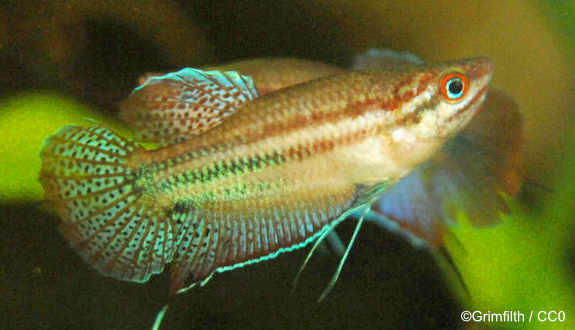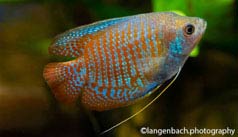

Alternative species (click on the thumbnail to see the card)
Names
Scientific name
Trichopsis vittata
Osphromenus vittatus
Trichopus striatus
Ctenops nobilis
Ctenops vittatus
Osphromenus striatus
Trichopsis harrisi
Trichopsis striata
Common name
Croaking gourami
Talking gourami
Knurrender Gurami (DE)
Origin

Origin: Cambodia, Thailand, Malaysia, Indonesia, Vietnam
Biotope: Asian
Dimorphism

Not very apparent. The mature female is slightly rounder than the male who approaches him with somewhat brighter colors. Against the light, by transparency, you can also observe the ovaries of the female which form a cluster in the abdomen.
Group
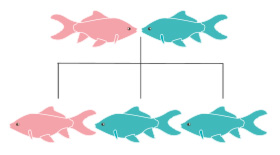
Osphronemidae
Volume

120 L / 26 imp gal / 32 US gal
Parameters

T°: 24 to 28°C or 75 to 82°F
pH: 6 to 7
Hardness: 5 to 15°dGH
Difficulty

Easy
Size

4 to 7cm (1.6 to 2.8")
Longevity

5 to 6 years
Living zone
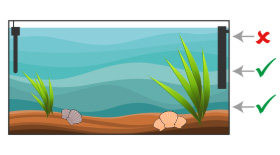
Middle and depth
Individuals
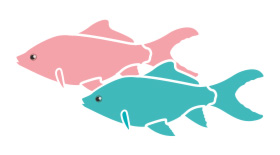
6 (harem)
Food
How to feed the Croaking gourami?
Food
How to feed the Croaking gourami?
This species is carnivorous with an insectivorous tendency. Most of its meals will consist of artemia or mud worms (fresh or frozen). Can also be on the menu mosquito larvae, Cyclops or Daphnia.
It also accepts freeze-dried food as a supplement. Vary as much as possible in order to avoid deficiencies and moreover, it will improve the coloration of your fish!
Note that it feeds mainly on the surface.
Behavior
What kind of behavior does the Croaking gourami have?
Behavior
What kind of behavior does the Croaking gourami have?
Generally speaking, this fish is active and peaceful, but note that it is a bit territorial. Its intra- and interspecific relationships are very good, making it an ideal candidate for community aquariums.
Cohabitation
Who can live with the Croaking gourami?
Cohabitation
Who can live with the Croaking gourami?
Very sociable, this fish appreciates the presence of its congeners. A small group of 6 is perfect in the most modest volumes (be careful not to go below 120 L / 26 Imp gal / 32 US gal anyway). Compose your group with 1 male for 2-3 females. Sometimes the males can fight a little.
For the other species, the ideal is to choose among small bearded animals to accompany this Gourami. Avoid very territorial, aggressive or large fish that can disturb the tranquility of the Gouramis.
Breeding
How to breed the Croaking gourami?
Breeding
How to breed the Croaking gourami?
It is quite easy to breed this species of Gourami. However, you will have to plan a second tank of 50-60 L / 11-13 Imp Gal / 13-16 US Gal for the breeding of the fry. Do not put any floor and fill with water from the main aquarium to the height of 15-20 cm or 6-8" (identical parameters). Put in floating plants to allow the male to build his nest. A light filtration (with a small foam filter) will ensure a good water quality but should absolutely not create eddies. Finally, this aquarium must absolutely be covered and as airtight as possible (this is essential in the development of the fry).
To stimulate spawning, feed the adults with live prey (mosquito larvae, mud worms...) for a few weeks. Introduce the chosen pair into the breeding aquarium and gradually increase the temperature up to 30°C or 86°F. Usually, reproduction is triggered after a change of water.
The courtship parade begins and you can then hear some kind of growling from the males, hence the name Gourami "croaking". The male builds a bubble nest just below the surface of the water among the floating plants. This nest is very fragile: be careful that no current flows in this area so as not to destroy the nest. The male hugs the female who then releases a few eggs. The operation is repeated in this way for about 2 hours. A whole clutch can contain between 70 and 180 eggs. The male catches his eggs then places them in the nest of bubbles. Sometimes the female also does this but it is preferable to remove her from the breeding aquarium as soon as the eggs are laid.
Incubation lasts about 30 hours. After hatching, the fry will resorb their yolk sacs (food reserve for the first days) after 2 to 3 days: this is free swimming. This is the time to remove the male in its turn.
The fry have a fast and regular growth. The critical moment of their growth is the formation of the labyrinth (the organ that allows the air at the surface to breathe) because the ambient air must be sufficiently humid and warm. To do this, cover and close the breeding tank tightly. This step takes place between the fourth and fifth week of development.
Feeding of the fry: parameciums, rotifers and cyclops nauplias then after 10 days move on to the artemia nauplias.
Its aquarium
Which aquarium for the Croaking gourami?
Its aquarium
Which aquarium for the Croaking gourami?
In its natural environment, the Croaking gourami evolves in calm waters or with light currents. In aquariums, the filter must therefore be very soft and not cause too much current. For that, you can for example direct the discharge rod against a wall to attenuate the power of the current (and never install it on the surface with this species). As far as parameters are concerned, this species is not very demanding but will be more comfortable with the following parameters: temperature between 25 and 26°C, a pH at 6.5 and a hardness between 3 and 8°dGH.
Plant your aquarium densely because this fish likes places rich in plants where there are many hiding places. Opt for example for Cryptocorynes or Microsorums. Do not hesitate to also use surface plants which will attenuate the luminosity (Riccia, Salvinia, Ceratopteris...). Finally, complete with peat bog roots to give height to your decor.
On the ground, opt for a dark color that will bring out the colors of your fish. You can cover it with a carpet made of branches and dead leaves: natural effect guaranteed! You can also place a few coconut halves for the Gouramis to hide in.
Cover your aquarium well for two reasons: the first is that this Gourami is an excellent jumper and it could end up dried on your tile. The other reason is that this fish occasionally comes to breathe the ambient air and that it must be relatively humid, that's why it requires some waterproofing of the aquarium.
In summary, the ideal aquarium for this Gourami is common to the majority of Osphronemidae: many, many plants, especially on the surface and a very weak or even non-existent current. The LowTech technique is therefore very suitable for Gourami.
Good To know
Find all additional information!
Good To know
Find all additional information!
His name « croaking » gourami comes from the peculiar noise (similar to a growl) that the male makes during courtship, or sometimes during fights between fish.
Rather robust and not very prone to diseases, this species can be maintained by a beginner in aquaristics.
There are different varieties of this species, linked to its vast geographical distribution:
Kaeng Krachan Dam
Trenggam Kuantan
Double Spot
Bleue (= Trichopsis harrisi)
Yours photos!
Comments
Sort by:
Please login to post comments
